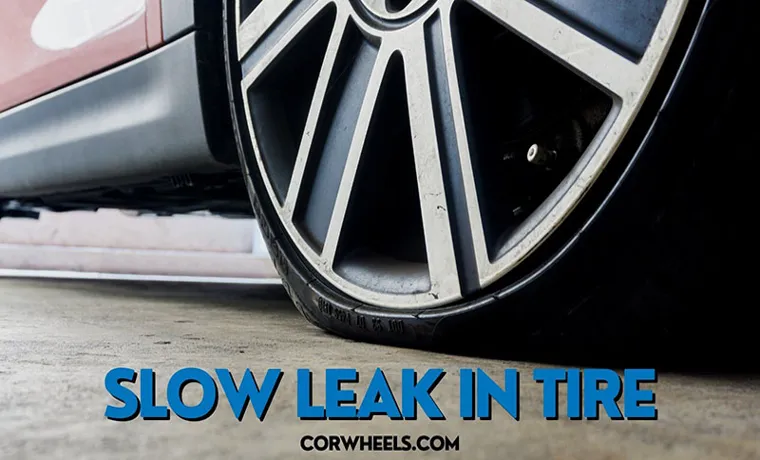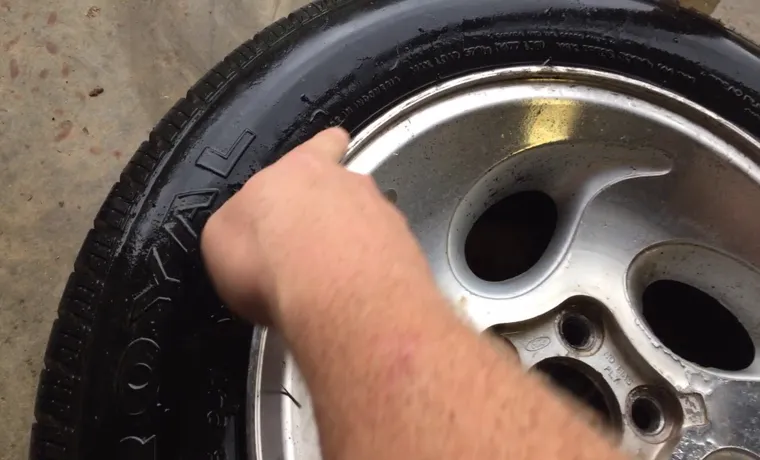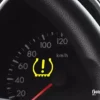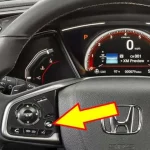Have you ever been driving down the road and suddenly noticed your tire pressure warning light? It’s an alarming feeling because you don’t know if you can make it to the next service station or if your tire is going to give out any second. But what if you have a slow leak, and your tire isn’t immediately deflating? It can be easy to ignore the problem and continue driving on. However, it’s essential to take care of a slow leak.
Driving on an underinflated tire can cause the tire’s sidewalls to weaken and potentially blow out. In this article, we’ll explore how to fix a tire with a slow leak, and how to prevent future issues with your tires.
Table of Contents
Identifying the Issue
If you notice your tire slowly losing air, there is a good chance that you have a slow leak. The first step in fixing a tire with a slow leak is identifying the issue. Start by inspecting the tire to locate the source of the leak.
Look for any sharp objects, such as nails or screws, that might be sticking out of the tread. If you find any, carefully remove them and see if there is a leak. If you don’t find any visible punctures, you may have a leaky valve stem.
This can be caused by a damaged or worn out valve or valve cap. In this case, simply replacing the valve or valve cap should solve the problem. Once you have identified the cause of the slow leak, you can then take the appropriate action to fix the tire and ensure it is safe to drive on.
Inspect the tire for any visible punctures or damage
When it comes to identifying issues with your tire, the first step is to inspect it for any visible punctures or damage that may have occurred. This can include anything from a nail or screw embedded in the tire to a sharp object that has caused a tear or gash in the rubber. It’s important to be thorough during your inspection, checking every inch of the tire to ensure that there are no hidden punctures or damage that could cause further problems down the line.
If you do notice any punctures or damage, it’s important to address them immediately to avoid any further damage to the tire. With a little bit of careful inspection and attention to detail, you can identify any issues with your tire and take the necessary steps to keep yourself safe on the road. Remember to always prioritize safety when it comes to your vehicle, and never hesitate to seek professional assistance if you’re unsure about any issues you may encounter.

Check the valve stem for any leaks or damage
When it comes to maintaining the health of your car’s tires, checking the valve stem is an essential step. A valve stem is responsible for retaining air in the tire and releasing it when necessary. Any leaks or damage to the valve stem can result in low tire pressure, which can be a safety hazard.
So, how can you identify if there’s an issue with the valve stem? First, visually inspect the valve stem for signs of damage like cracks or bends. Then, use a tire pressure gauge to check the air pressure. If the pressure is lower than it should be, the valve stem may have a leak.
You can also try spraying a soapy solution on the valve stem while the tire is inflated to see if any bubbles form, which indicates a leak. By regularly checking your valve stems, you can avoid potential hazards on the road and prolong the lifespan of your tires.
Use soapy water to locate leaks on the tire or rim
If you’ve got a leaking tire or rim, soap could be your savior. Why? Well, a soapy solution does an excellent job of detecting where the leak is coming from. To do this, mix up a cup or two of warm soapy water and apply it to the tire.
Focus on the valve stem, the tire’s sidewalls, and the tread surface first. If the solution bubbles up anywhere, that’s a clear indication of a leak. The same method works for rim leaks.
Simply apply the solution to the rim’s surface and the edges before checking for any bubbles. Identifying the issue is the first and most crucial step in fixing it. By utilizing this simple technique, you can quickly locate the leak and proceed with repairs.
So next time you need to locate a leak, remember to reach for the soap and water.
Temporarily Fixing the Tire
If you’re dealing with a tire with a slow leak, you might be able to temporarily fix it and get where you need to go. The first step is to locate the leak. You can do this by spraying the tire with soapy water and looking for bubbles.
Once you’ve found the leak, remove any debris from the area. If you have a tire kit with you, you can use the rubber plugs to temporarily seal the hole. Insert the plug into the hole and use the reamer tool to secure it in place.
You can also use a tire sealant to seal the hole until you can get to a professional. Remember, these temporary fixes are just that, temporary. It’s important to have a professional examine and repair your tire as soon as possible to avoid any safety issues on the road.
Remove the object causing the puncture (if visible)
When your tire suddenly loses air, the first step to take is to check for any visible punctures and remove any object that may have caused the damage. Once the object has been removed, the next step is to temporarily fix the tire until it can be properly repaired. This can be done by using a tire plug or a can of tire sealant.
If using a tire plug, first insert the plug into the puncture and then trim the excess plug material. If using tire sealant, simply attach the can to the tire valve and follow the instructions on the can for inflating the tire. It’s important to keep in mind that temporary fixes are just that – temporary.
Properly repairing or replacing the tire is necessary for long-term safety on the road. Always check your tire pressure regularly and inspect your tires for any signs of damage. This will help prevent sudden flat tires and ensure your safety while driving.
Insert a tire plug or apply tire sealant according to product instructions
If you’re out on the road and experience a flat tire, your main goal should be to fix it temporarily so you can safely make it to a repair shop. One solution is to insert a tire plug or apply tire sealant according to the product instructions. A tire plug is a rubberized, threaded strand that is inserted into the puncture hole, which expands and seals the hole.
On the other hand, tire sealant coats the tire’s interior and seals the hole immediately. Whichever option you choose, make sure to follow the instructions on the product label precisely to ensure proper usage. These temporary fixes are meant to help you safely reach your destination, but they are not permanent solutions.
You should still have your tire repaired or replaced as soon as possible to avoid any further issues. Remember, safety should always be your top priority when dealing with a flat tire on the road.
Reinflate the tire and check for leaks
When you find yourself with a flat tire, it’s important to know how to temporarily fix it before making your way to a professional mechanic. The first step is to locate the puncture and remove any objects that may be lodged inside. Once the foreign object has been removed, it’s time to reinflate the tire and check for leaks.
Of course, this is assuming you have a spare tire and the necessary tools to take off the punctured tire. A punctured tire can lose air quickly, so it’s important to work as efficiently as possible to avoid further damage. If the puncture is small enough, it may be possible to plug the hole temporarily with a tire patch kit until you’re able to have it professionally repaired or replaced.
Remember, this is only a temporary fix and should not be relied upon for extended periods of time. It is always best to have a professional examine the tire as soon as possible to ensure your safety on the road.
Permanent Solutions
If you’ve got a slow leak in your tire, there are a few permanent solutions to consider. One popular option is to patch the tire from the inside, either with a patch kit or by taking it to a professional tire service. This method will ensure that the tire stays fixed and doesn’t leak any air.
Another option is to replace the tire altogether, especially if it’s damaged or worn out. It can be costly, but this will provide long-lasting peace of mind. Remember to check your tire pressure regularly and avoid hitting any potholes or sharp objects that can puncture your tire.
With proper maintenance, you can prevent slow leaks and keep your tires in good condition. So don’t wait until you’re stranded on the side of the road with a flat tire – take care of it now and save yourself the hassle in the long run.
Take the tire to a professional for patching or replacement
When it comes to fixing a flat tire, there are a few options you can consider. However, if you want a permanent solution, it’s best to take the tire to a professional for patching or replacement. While it may be tempting to try to fix the tire yourself, it’s important to remember that a patched tire may only last a limited amount of time or not provide a secure fit.
Plus, incorrectly repairing a tire can lead to further damage or even a blowout on the road. By taking the tire to a professional, you can ensure that it is properly repaired or replaced with a new one, giving you peace of mind while driving. So, if you’re ever faced with a flat tire, trust the experts and take it to a professional for a long-lasting fix.
Consider getting new, more durable tires to avoid future issues
If you’ve experienced tire blowouts or punctures in the past, it may be time to consider investing in new, more durable tires. While it may seem like an additional cost upfront, getting high-quality tires can not only prevent future issues but also improve your driving experience overall. Permanent solutions like getting durable tires can save you money in the long run by avoiding the need for constant tire replacements or repairs.
Plus, having reliable tires can give you peace of mind, especially when driving on rough roads or during inclement weather conditions. So, next time you’re due for new tires, consider upgrading to a more durable option to ensure a smoother and safer ride.
Conclusion
In conclusion, fixing a tire with a slow leak is a relatively easy and manageable task. With the right tools and a little bit of know-how, you’ll be back on the road in no time. But like with any problem, it’s always best to address it sooner rather than later.
Don’t let that slow leak eventually become a fast flat. So, next time you find yourself with a low tire, remember to stay calm, keep it cool, and patch that puncture like a pro! Happy and safe motoring!”
FAQs
What causes a slow leak in a tire?
A slow leak in a tire can be caused by various factors, such as a puncture, a damaged valve stem, a cracked wheel, or a corroded bead seat.
How can I detect a slow leak in my tire?
You can detect a slow leak in your tire by checking the tire pressure regularly, inspecting the tread for signs of wear, listening for hissing sounds, and using soapy water to find bubbles around the valve stem and bead seat.
How do I fix a slow leak in my tire?
To fix a slow leak in your tire, you can use a tire plug or patch kit, apply rubber cement to the punctured area, insert the plug or patch with a plugger, and inflate the tire to the recommended pressure.
Is it safe to drive with a tire that has a slow leak?
It is not safe to drive with a tire that has a slow leak, as it can cause the tire to deflate suddenly, lose traction, and lead to a potential accident. It is recommended to replace or repair the tire as soon as possible.
How often should I check my tire pressure to prevent a slow leak?
You should check your tire pressure at least once a month, or before long trips, to prevent a slow leak and ensure proper inflation. You can use a tire pressure gauge or a digital inflator to check the pressure.
Can I repair a tire with a slow leak myself, or should I seek professional help?
You can repair a tire with a slow leak yourself if you have the necessary tools and expertise, or you can seek professional help from a tire shop or mechanic. However, if the tire is severely damaged or the leak cannot be fixed, you may need to replace the tire.
How can I avoid getting a slow leak in my tire in the future?
You can avoid getting a slow leak in your tire in the future by maintaining proper tire pressure, avoiding overloading or underinflating the tire, driving carefully on rough roads, avoiding sharp objects or debris, and getting your tires checked regularly by a professional.



